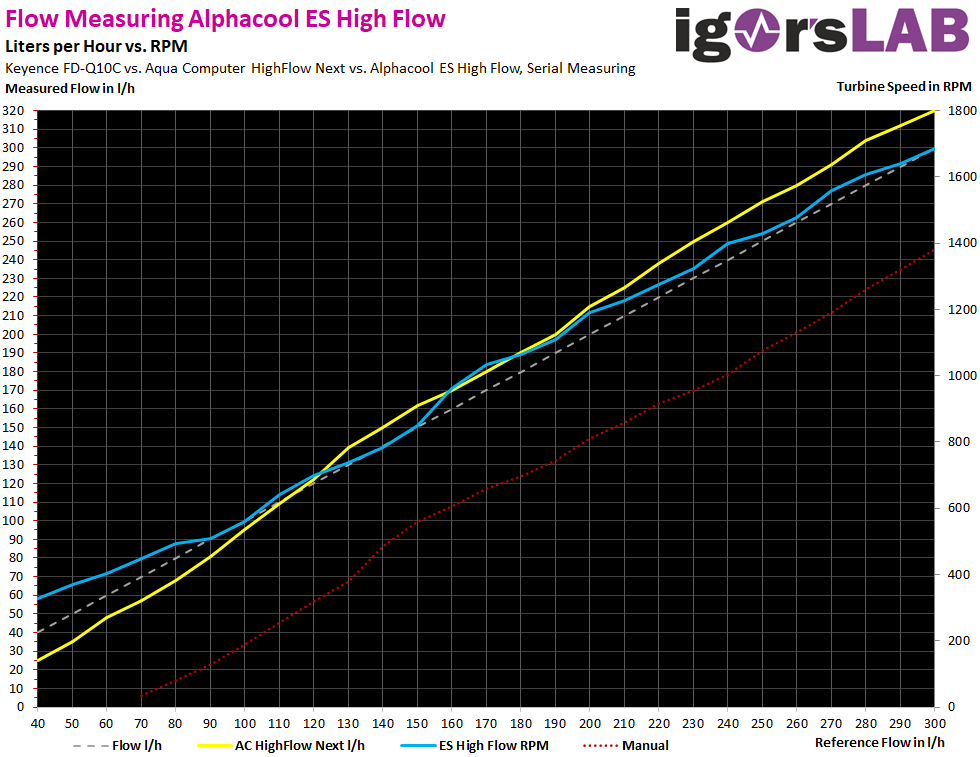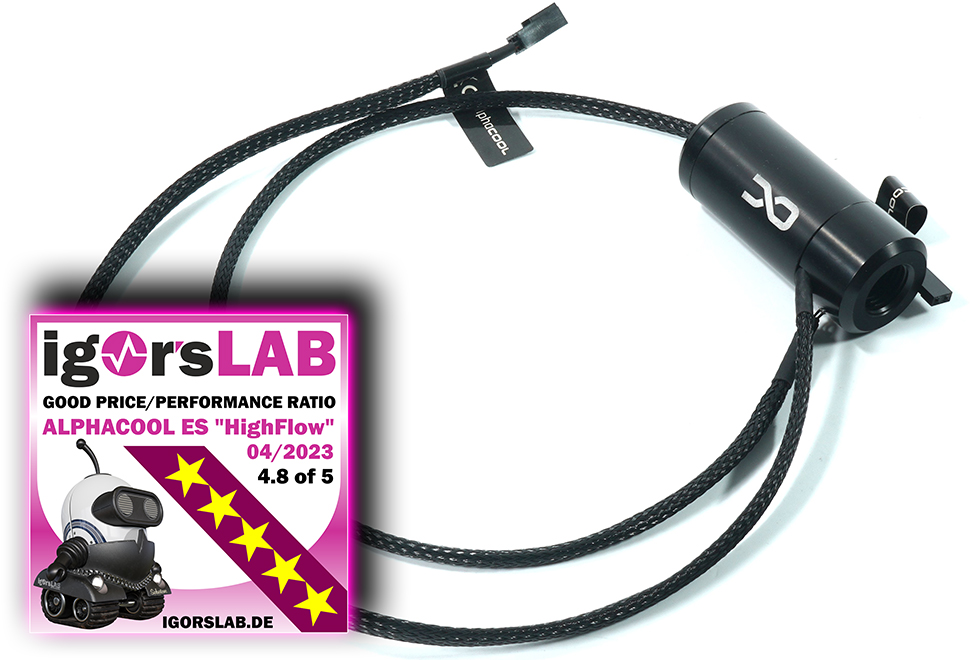Measurement results and evaluation
Now let’s look at the diagram, which has two Y-axes and one X-axis, which represents the actual flow in l/h. The left Y-axis, on the other hand, shows the output measured value in l/m for the reference sensor (gray dashed line), as well as the directly readable “High Flow Next” from Aqua Computer (yellow line). The normalized blue line shows the adequate RPM of the Alphacool ES sensor measured at the pump port of the motherboard (MSI Z690 Mortar).
The red dashed line shows the data from the manual, but unfortunately they are completely wrong and much too low. I have already informed Alphacool, so that will be improved here. For all users (and possible interested parties), I will of course have the exact table with all measured data later, which gives a quite stable factor of ideally 5.6:1 between speed and flow. But that will come in a moment. Instead, let’s look at our chart first:
Starting at around 100 l/h, the Alphacool ES sensor is even significantly closer to the ideal line of the reference sensor, which is quite astonishing. Especially in the range above 200 l/h it is almost congruent with the original, while the sensor from Aqua Computer shows a little too much. Below 100 l/h, both sensors behave very differently, with Alphacool’s sensor displaying more to almost the same extent that Aqua Computer’s sensor outputs too little. Both sensors break down completely below a true 40 l/h, with the Alphacool sensor simply stopping abruptly below a minimum speed of 300 rpm.
However, the measured values also show that both sensors rightly bear the “high flow” in their names, because below around 100 l/h, both actually only output inaccurate values if a constant factor were to be applied. Unless you have the table with the real speeds at a defined flow rate at hand. This is then the advantage of the read RPM, where a simple electronics simply can not convert well. The corrected table now shows the RPM of the Alphacool sensor and the resulting factor compared to the reference:
| Flow l/h | AC HighFlow Next l/h | ALC ES High Flow RPM | Factor RPM/Flow |
| 40 | 25 | 327 | 8.175 |
| 50 | 35 | 369 | 7.380 |
| 60 | 48 | 404 | 6.733 |
| 70 | 57 | 449 | 6.414 |
| 80 | 68 | 493 | 6.163 |
| 90 | 81 | 510 | 5.667 |
| 100 | 95 | 560 | 5.600 |
| 110 | 109 | 640 | 5.818 |
| 120 | 122 | 700 | 5.833 |
| 130 | 139 | 737 | 5.669 |
| 140 | 150 | 783 | 5.593 |
| 150 | 162 | 850 | 5.667 |
| 160 | 170 | 960 | 6.000 |
| 170 | 180 | 1034 | 6.082 |
| 180 | 190 | 1064 | 5.911 |
| 190 | 200 | 1110 | 5.842 |
| 200 | 215 | 1192 | 5.960 |
| 210 | 225 | 1228 | 5.848 |
| 220 | 238 | 1275 | 5.795 |
| 230 | 250 | 1322 | 5.748 |
| 240 | 260 | 1398 | 5.825 |
| 250 | 271 | 1430 | 5.720 |
| 260 | 280 | 1477 | 5.681 |
| 270 | 291 | 1560 | 5.778 |
| 280 | 304 | 1608 | 5.743 |
| 290 | 312 | 1640 | 5.655 |
| 300 | 320 | 1685 | 5.617 |
Summary and conclusion
There is probably currently no real “low flow” sensor, which also shows the range below 100 l/h usable as a real display or readout result in l/h, unless you simply calculate yourself and use the list with the actual rpm of the Hall sensors for a certain value. A rather simple sensor with a tachometer signal even has an advantage over those whose electronics calculate themselves, but usually have to rely on a fixed conversion factor.
The fact that this then goes wrong below a certain limit is due to the design. Then you would need smart electronics with a stored curve and at least 30 comparison values to compensate for what the user can manage using the table. That’s just the way it is and unfortunately it can’t be changed. But here, convenience and accuracy get in the way a little. And that is exactly why the above table also includes the readout value of Aqua Computer’s “High Flow Next” as a small service on my part, so that the user has a better indication of what is actually flowing through.
The Alphacool ES flow and temperature sensor “HighFlow” is at least more accurate than I expected, which makes me quite optimistic. Now a smart evaluation with stored values for rpm including flow rate and life would be almost perfect. Unfortunately, this is no longer possible for this price. But it doesn’t have to, because you can have this sensor evaluated via the motherboard during operation. And as a master water engineer, you can certainly do some calculating and comparing.
Alphacool ES "HighFlow", Durchfluss- und Temperatursensor mit Tachosignal (17558)
 | Zentrallager: verfügbar, Lieferung 3-5 WerktageFiliale Wilhelmshaven: nicht lagerndStand: 27.04.24 00:50 | 36,89 €*Stand: 27.04.24 00:51 |
 | Alsdorf: bei Vorbestellung in ca. 24h - 48h lagerndVersandlager: lagerndStand: 26.04.24 23:45 | 36,90 €*Stand: 26.04.24 23:46 |
 | Lagernd im Versandlager - Lieferzeit 2-5 Werktage | 39,07 €*Stand: 26.04.24 23:50 |


































17 Antworten
Kommentar
Lade neue Kommentare
Urgestein
1
Urgestein
Urgestein
Urgestein
1
Urgestein
1
Mitglied
Neuling
Urgestein
Veteran
Urgestein
1
Mitglied
Mitglied
1
Alle Kommentare lesen unter igor´sLAB Community →